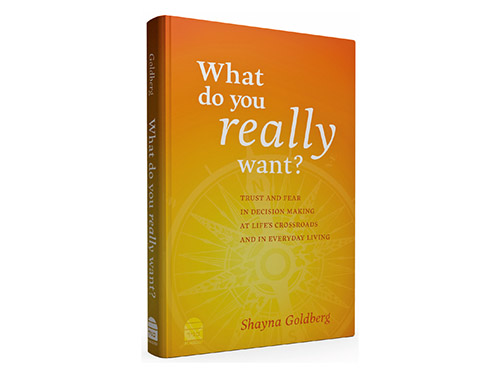
Reviewing: “What Do You Really Want?” by Shayna Goldberg. Maggid Books, 2021. English. 180 pages. ISBN-13: 978-1592645718.
Decision-making may have grown more difficult in the contemporary world. Technology and affluence present us with a dizzying array of choices. The postmodern condition robs us of a secure backdrop of values and identity from which to arrive at a decision. Thus, Shayna Goldberg’s “What Do You Really Want?: Trust and Fear in Decision Making at Life’s Crossroads and in Everyday Living” (Maggid Books) is a timely contribution. Goldberg, an educator at the SKA Beit Midrash for Women of Yeshivat Har Etzion (Migdal Oz), brings to bear years of experience counseling students with beneficial results.
“What Do You Really Want?” calls for a decision-making process based on trust and confidence and not on fear. Part one, the strongest section of the book, catalogs bad reasons to make decisions and good principles on which to base them. Among the poor factors driving judgments are considering what others will say or think, concern about a blow to our self-perception, an unwillingness to admit mistakes, fear of failure or rejection, and the pain in having to revisit questions that appeared closed. Conversely, positive decision-making comes from doing adequate research, honesty regarding the two sides of the equation, trusting ourselves rather than acting out of trepidation, and focusing on the next best decision and ignoring future, unknowable factors. Goldberg opted not to cite many Torah sources because the volume’s approach relates to the human condition per se, and she aims for a universal angle. This may seem curious to the reader, since her helpful case study scenarios address personal particularistically Jewish dilemmas, such as “Should I make aliyah?” or “Should I stay shana bet?” which may not be fully understandable to those outside the orbit of people who would have easily related to Torah sources. I would have enjoyed seeing her root more of her advice in traditional rabbinic discourse. For example, she could have analyzed Chazal’s statement that a judge (rendering a decision) only has “what his eyes can see” (Sanhedrin 6b). The following quote from R. Joseph B. Soloveitchik would have been especially pertinent since it bolsters one of Goldberg’s central theses.
“Apparently, there is a subjective element in making moral decisions. If one is confused, he can ask for guidance and counsel. Many times I have been presented with such moral questions. I never give a yes or no answer. The questions may determine the future of a particular individual. I will explain the options but tell him that the final choice is his. These are occasionally the most important of problems. Many times when my own students ask me such questions, I explain to them what is involved. They have to understand the alternatives. I resent very much when certain roshei yeshiva and certain teachers want to impose their will upon the boys. It is against the law. Both ways are correct, the options are correct, and it is up to the individual to make the decision” (cited in A. Rakeffet, The Rav, vol.2, 237).
Indeed, Goldberg strongly emphasizes the autonomy of the decision-maker. At the end of the day, individuals struggling with weighty decisions must trust their gut. A teacher or counselor can help frame the question but the decision remains with the person him or herself. The earlier part of the book assumes this vantage point and chapter eighteen provides solid arguments for it. (There may have been some value in presenting the arguments for autonomous decision-making earlier in the volume.)
Though the ideology articulated is not specific to observant Jews, the themes of the book have great significance for our community beyond the issue of decision-making. Do we motivate Jewish commitment through guilt and fear (antisemitism, assimilation, fear of punishment) or by exposing our youth to the beauty and wisdom of our tradition? Do we allow rabbis and teachers to become gurus with all the answers, a phenomenon with frequently dangerous consequences, or do we instruct our students to trust their own discerning judgment? Even in my relatively liberal Modern Orthodox orbit, I encounter students tempted to hand over responsibility to mentors and teachers inclined to adopt the omniscient perspective. “What Do You Really Want?” helps counter these problematic trends.
The author’s willingness to share some of her own decision-making conundrums is another impressive aspect of this work. Several of the case studies relate to Goldberg’s personal life. Such candid reflections enhance a work calling for more honesty when facing questions. She also makes the crucial point that following the “best practices” does not automatically ameliorate tension. Life presents us with difficulties not allowing for easy answers, and even the most intelligent plan leaves us somewhat insecure.
I emphasize that Goldberg wants individuals to make decisions based on their deeper wants and not based on a fleeting desire to stay in bed or the like (22). She calls for identifying core values that guide our deliberations (139). At the same time, Goldberg instructs the reader to make decisions based on where they actually are and not on where they would like to be. Someone who thinks they should be more Zionistic might truly want to stay in America and has to consider aliyah from his or her authentic place. In one of her scenarios, a fellow signs up for a learning program that he is not truly ready for because he thinks he should be in that headspace (53). While I endorse the basic point, the volume could incorporate more about the value of what we “want to want” and how that factor should play some role in our reflections.
Goldberg provides an important resource both for teachers and parents guiding the decisions of others and for those making the decisions themselves.
Yitzchak Blau is associate editor of Tradition and rosh yeshivat Orayta. Originally published by “Tradition: A Journal of Orthodox Jewish Thought” at www.TraditionOnline.org.













